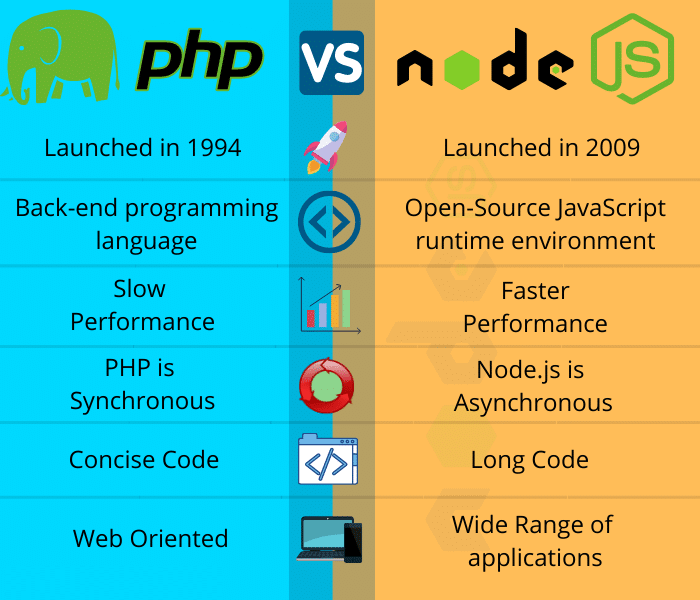
When it comes to backend development, two popular choices stand out: PHP and Node.js. Both have distinct strengths and are widely used by developers for building dynamic, server-side applications. However, deciding between PHP and Node.js can be challenging if you’re unfamiliar with what each has to offer. In this article, we’ll explore the key differences, benefits, and scenarios where each is best suited, so you can make an informed choice.
Understanding PHP
PHP, or Hypertext Preprocessor, has been around since 1995 and has long been a staple for web development. Known for its ease of use, PHP is especially popular among beginners and has an extensive support community. Here’s why it remains a popular choice:
- Simplicity – PHP is known for its straightforward syntax and ease of integration with HTML, making it accessible for beginners.
- Compatibility – PHP works well with almost all web servers and supports multiple databases, including MySQL, making it versatile.
- Established Ecosystem – With years of development, PHP has a vast array of frameworks (like Laravel and Symfony) and a robust content management system ecosystem, with platforms like WordPress and Joomla.
PHP shines in scenarios that involve content-heavy websites, where rapid deployment and extensive third-party integrations are needed. However, while it’s great for traditional web applications, PHP does have limitations when it comes to real-time applications and more modern development practices.
Understanding Node.js
Node.js, introduced in 2009, is a JavaScript runtime built on Chrome’s V8 engine. It allows developers to use JavaScript on the server side, making it possible to write both frontend and backend code in the same language. Some of its core benefits include:
- Non-Blocking I/O – Node.js uses an event-driven, non-blocking I/O model, which allows for handling multiple requests concurrently. This makes it highly efficient and suitable for real-time applications.
- Unified Language – With JavaScript on both the client and server sides, Node.js simplifies development for teams who work across the full stack.
- Vibrant Ecosystem – The npm (Node Package Manager) ecosystem in Node.js is vast, allowing developers to leverage numerous libraries and modules for a range of functionalities.
Node.js is especially useful for projects that require real-time functionality, such as chat applications or collaborative tools. Its event-driven architecture also makes it ideal for handling asynchronous operations, which are essential for applications that demand high speed and responsiveness.
Key Differences Between PHP and Node.js
1. Performance
- PHP: PHP executes each request in isolation, which can be slower when handling high loads. While PHP 7 and newer versions have significantly improved performance, it may still lag behind in real-time applications.
- Node.js: Node.js uses an asynchronous, non-blocking model, which means it can handle multiple requests without waiting for tasks to complete. This leads to faster, more efficient handling of concurrent connections.
2. Concurrency and Asynchronous Handling
- PHP: Traditionally, PHP works in a synchronous manner, handling one request at a time. Although you can achieve asynchronous programming in PHP using extensions, it’s not as native or seamless.
- Node.js: Node.js is inherently asynchronous and excels at managing concurrent tasks, making it ideal for real-time applications where rapid response times are crucial.
3. Data Handling
- PHP: PHP’s compatibility with MySQL databases makes it ideal for applications where relational data is key, such as content management systems.
- Node.js: Node.js often pairs with NoSQL databases like MongoDB, where a flexible schema is advantageous. This setup works well for applications that need to handle large volumes of unstructured data.
4. Learning Curve
- PHP: PHP’s syntax is simple and intuitive, especially for those who already know HTML. It’s beginner-friendly and has extensive documentation, making it easy for new developers to learn.
- Node.js: Although JavaScript knowledge helps, the asynchronous nature of Node.js can be challenging for beginners. It requires a deeper understanding of callback functions and promises, which might be intimidating at first.
5. Use Cases
- PHP: Best suited for traditional web applications, CMS platforms, and e-commerce sites.
- Node.js: Ideal for applications that require real-time interaction, such as chat applications, collaborative tools, and streaming platforms.
When to Choose PHP?
PHP is an excellent choice when:
- You need to build a traditional web application, such as a content-heavy site.
- Your project depends on popular CMS systems like WordPress or Joomla.
- You are looking for a cost-effective solution that is easy to maintain.
PHP’s extensive library support and broad hosting compatibility make it an attractive option for projects that require rapid deployment and don’t have real-time data handling needs.
When to Choose Node.js?
Node.js is preferable when:
- You are developing real-time applications, like chat apps or online gaming.
- Your project needs to handle multiple requests simultaneously and efficiently.
- You want to unify the development team under one language, JavaScript, for both client and server sides.
For tech startups or companies focusing on innovative and dynamic applications, Node.js offers scalability and efficiency, especially with applications that require continuous interactions.
PHP and Node.js Together: Hybrid Approach
Interestingly, you don’t always have to choose between PHP and Node.js; many organizations use both technologies in different parts of the same project. For instance:
- Content Management: You could use PHP for the CMS portion, where it excels at handling content-related tasks.
- Real-Time Features: Node.js could be leveraged to manage chat systems, notifications, or live feeds on the same platform.
This hybrid approach allows you to maximize the strengths of both technologies, using each where it performs best. Many companies find this combination effective in delivering complex applications with diverse functionality.
Conclusion
Deciding between PHP and Node.js ultimately comes down to your specific project requirements. PHP is a trusted solution for traditional web applications and content-heavy websites, offering simplicity and a vast support ecosystem. In contrast, Node.js provides a modern approach with high-speed, event-driven performance, making it ideal for real-time applications and services.
In many cases, blending both technologies might offer the best of both worlds, especially for projects that benefit from PHP’s CMS capabilities and Node.js’s efficiency in handling real-time data. By assessing your project’s needs, you can make an informed choice that aligns with your goals and resources.













